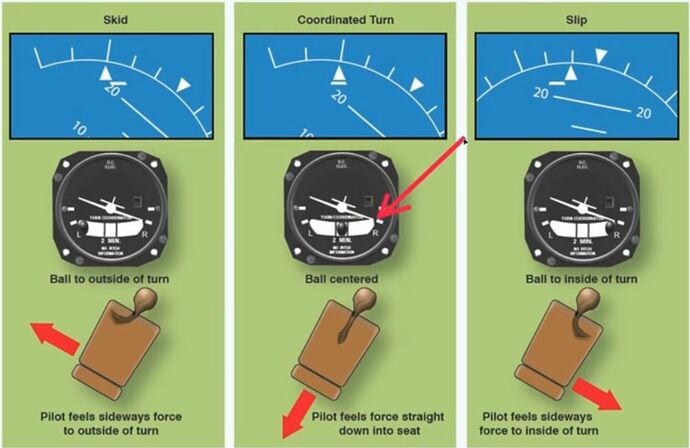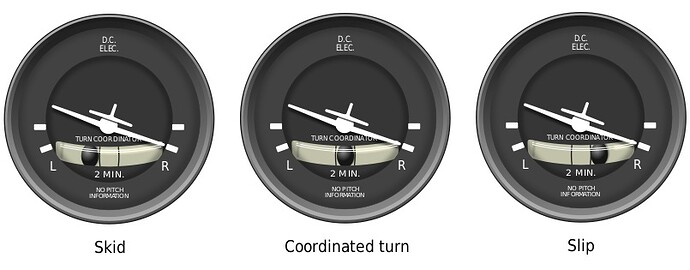With the default 4.3, it’s grossly too much drag for sure. 0.8 feels about right in the 172 though it could be a tad more or less. A touch of power on roundout and it’s close to perfect.
That’s a tuning thing, but the underlying problem that these values are off still remains.
The contradictions in the SDK plus the high 4.3 value in the C172 G1000 which is way off from the suggested 0.2 - 0.8 are enough to question everything.
At the end only MS/Asobo can clarify.
I’m wondering - does the sim calculate AoA granularly for each wing during any phase of flight, or is resulting AoA only changed by aircraft AoA and aileron/flap position?
Or phrased a different way - does roll moment affect AoA in the sim?
The reason I ask is I have a tough time getting a plane to spin to the opposite direction of a turn, as might happen in a slip. Or worse, when trying to use ailerons to raise a wing during a stall. It doesn’t have the effect I would expect, and I think that while it’s a different problem, the root might correlate with the adverse yaw issue.
The short answer is yes. The long answer is it depends. It depends on what has been configured in the flight model in terms of aileron throw, stall behaviour (of which there are something like 8 variables that DIRECTLY impact it and several more that indirectly affect it), CFD on/off, wing loading, etc etc etc
While certainly true in general, it is suspicious that virtually almost all planes developed for this sim demonstrate no or very minor adverse yaw whatsoever compared to real life, even those with high wing aspect ratios. While Asobo states, adverse yaw should be there quasi naturally, by both aileron drag differential and airplane_geometry.
That hints - for adverse yaw - indeed at a problem with the “tools”, an error within the SDK…
Or an error in the SDK documentation, which is the latest suspicion. If your instruction manuals are wrong, it makes sense the products that come from it are flawed, as they are built on the same incorrect assumptions.
I tested it and I achieved - 5000 fpm in a nose dive, I was laughing so hard ![]()
So yes 4.0 is definitely a typo in the flightmodel.cfg Cessna and one time in the SDK documentation, it wouldn’t make any sense because it’s a drag coef.
However as the default number 0.4 seems way to low for most of the aircraft, after looking more into it.
I’m gonna quote a few very good comments from the bug report from @WartedSummer2 :
I can’t find any variable that would express each wing’s roll rate. It doesn’t seem to be simulated. Which would explain why gliders or a plane with high wing aspect ratio like the Porter PC-6 have virtually no adverse yaw in the sim. (Milviz/Blackbird has done only a minimal job porting the PC-6 to MSFS, no custom adjustments to the flight model regarding adverse yaw are visible in the .cfg)
Differential lift/drag from Roll rate is the main contributing factor for adverse yaw for these high wing aspect ratio planes.
It could be as simple as calculating the delta in bank angle over time. But if roll rate isn’t calculated at all, anywhere, then we’re also missing an important factor that goes into our turn coordinator indications.
Yes, someone from the 3rd party glider developer mentioned the broken turn coordinator implementation in MSFS. Now we maybe know why.
I also can’t find any wing roll rate values. Maybe it should get calculated when entering the Airplane geometry.
After further Testing:
rudder_lift_coef - has also a great effekt on YAW during turn. The smaller the coef, the greater the yaw. BUT this value is effected and scaled by rudder_effectivness and rudder_elasticity_table.
fuselage_lateral_cx - it feels, like this is also scaled by parasite_drag_scalar.
So the actual numbers should not be jugded without the scalars.
I found this explanation in the SDK:
roll_moment_yaw_rate
This is a legacy FSX parameter not used in the modern flight model. In the modern flight model this effect is natively obtained through aerodynamic simulation of the surfaces defined in the[AIRPLANE_GEOMETRY]section. In the modern flight model, most of the roll will be induced by the difference in lift between one wing and the other, and the rudder will work against this effect. Adjust the shape of the wing viawing_sweep,wing_dihedral,wing_twist,wing_camber, the position of the wing, and the vertical position of the rudder, the rudder area and rudder lift coefficient to adjust this effect. Some of these parameters will work against each others. Induced roll is a very complex effect to balance which will depend on many factors.
also every other parameter which has something to do with roll rate is linked to the airplane geometry in the modern flight model, so there are no simple adjustment numbers.
In other words effects of the aspect ratio of the wings should also be obtained as a result of the airplane geometry, if not then there are two possibilities:
- developers are doing something wrong with the airplane geometry
- something is wrong the core aerodynamic simulation of the modern flight model
If I may proffer a third possibility: we are comparing our unquantified perception of adverse yaw against a semi-quantified outcome in the sim. I’m by no means saying we’re on the wrong track, it’s probably more right than anything. I’m just saying there’s a lot of perception involved in our analysis that may be flavored by biases inherent in the spatial view we end up with in the sim. Camera angles, zoom, parallax, etc.
I’d like to see a more objective analysis: a 10° per second, uncoordinated roll to the right in a Warrior at this weight and CG, density altitude, and indicated speed, produces 2° per second left yaw during the roll, resulting in 2° additional apparent pitch above the horizon. In real life.
Then compare that to what the sim is doing.
good points!
One of the biggest problem to judge adverse yaw effect in MSFS is the camera movement, also in 3rd person view the camera pans automatically in the direction you are rolling.
Also the broken turn coordinator doesn’t help, which seems to be always centered no matter what.
I’m also for the obejective approach if somebody has real life numbers or videos for comparison and a better way to actually test what’s happening.
Home cockpit mode stops the cockpit wobbling around, only the scenery moves.
The problem is the head has to stay centered with the turn and not follow the nose of the airplane, because otherwise it will allways look like there is no adverse yaw. And with cockpit mode you completely follow the nose of the aircraft.
Another way to see adverse yaw would be the chase cam, but it’s sadly not possible to turn the auto panning off.
here is a real life example of looking at it
Careful with that one. At 3:40, he doesn’t recognize that the glass cockpit is indeed also indicating a skid, but it’s a turn in the opposite direction than is indicated in the analog TC, and so he mis-explains the way to center the indicator (as if it were a turn in the same direction). You should still “step on” the bar to center it under the triangle, just like the analog inclinometer.
I know it’s not his diagram, but it’s a pretty bad one to use for comparison purposes, leading to errors like this.
And the propeller causes adverse yaw… no.
I know exactly how it looks and feels in real life. I started flying in gliders at the age of 14, I am now well into retirement years ![]()
I use TrackIR so my head is wherever I want it to be.
I was first taught sideslip in a glider by a disabled pilot who only had use of one arm. He released the winch tow by attaching a cord to the release knob and pulling on it with his teeth. As he could not operate the airbrakes and fly the glider at the same time with only one hand he controlled all his landings using sideslip. He was expert at that.
His name was Pete Brown: Bannerdown Gliding Club.
That’s awesome!
So do you notice adverse yaw in any aircraft using TrackIR?
I’m also trying to understand how adverse yaw should look like on the skid/slip indicator.
When making a right turn it should look like a slip (picture 3) ?
If adverse yaw occurs the ball should move to the right at the beginning of the turn and if not corrected due rudder input it maybe will stay there / resulting in a slip or am I wrong?



